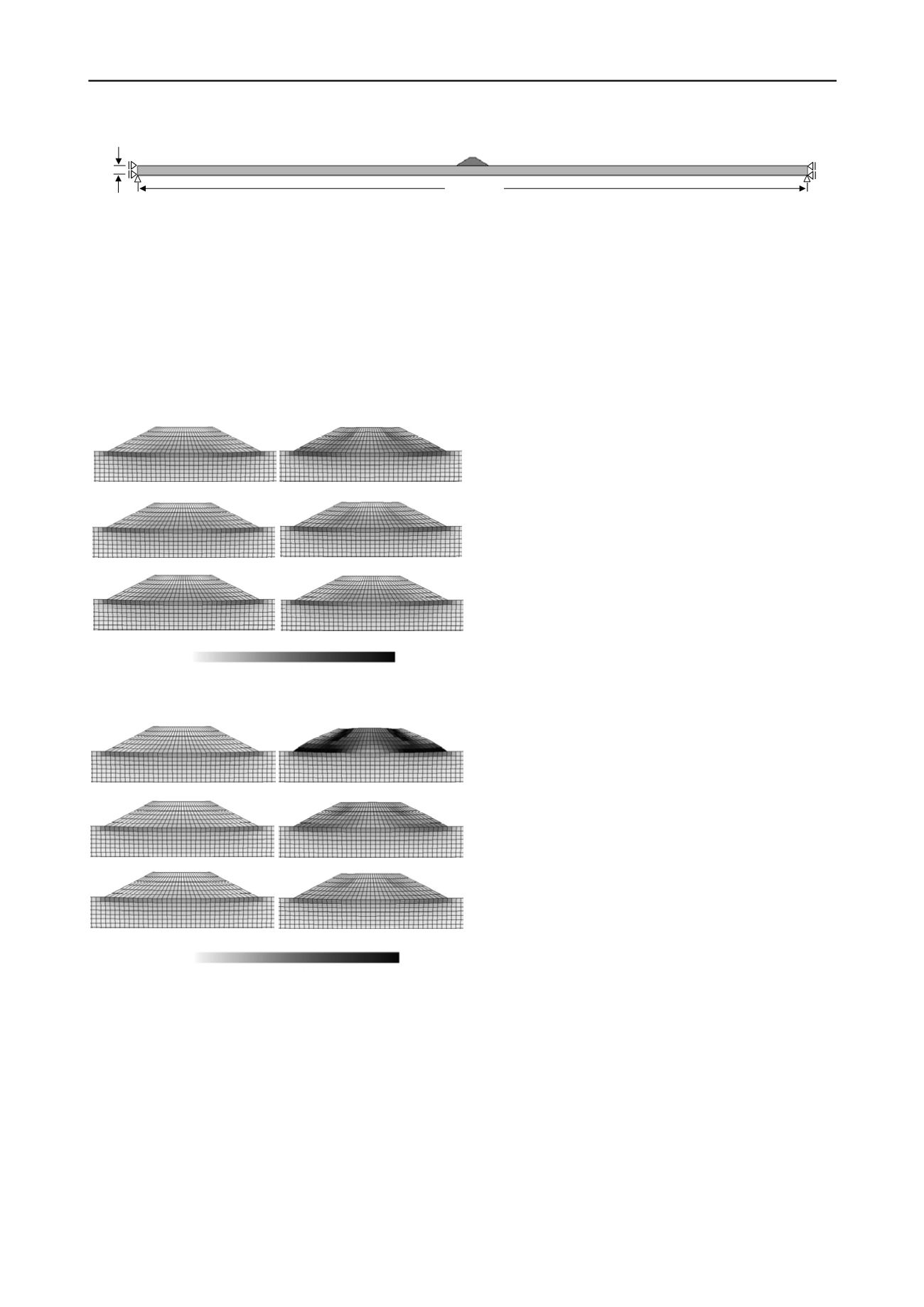
1182
Proceedings of the 18
th
International Conference on Soil Mechanics and Geotechnical Engineering, Paris 2013
Bottom edge impermeable
Left edge impermeable
Right edge impermeable
Ground surface permeable (atmospheric pressure)
20m
Figure 7. Analysis cross-section
1835.8m
was exhibited during and after the earthquake. For material C at
the 90% of Dc, a slip plane occurred from the top of the slope of
the embankment due to the earthquake, resulting in collapse.
However, it can be seen that as the Dc increased, the shear
strain due to the earthquake reduced, and the seismic stability
increased. From the above, it can be seen that greater seismic
stability can be obtained from embankments constructed with
materials with fast decay of structure and loss of
overconsolidation (material A) than from embankments
constructed from materials with little decay of structure, and
loss of overconsolidation (material C).
Degree of compaction: 90%
Degree of compaction: 95%
Degree of compaction: 100%
Immediately after the earthquake
Immediately before the earthquake
0
4
8 12 16 20%
Degree of compaction: 90%
Degree of compaction: 95%
Degree of compaction: 100%
Figure 8. Shear strain distribution (material A)
Degree of compaction: 90%
Degree of compaction: 95%
Degree of compaction: 100%
Immediately after the earthquake
Immediately before the earthquake
0
4
8 12 16 20%
Degree of compaction: 90%
Degree of compaction: 95%
Degree of compaction: 100%
Figure 9. Shear strain distribution (material C)
6 CONCLUSIONS
In this research, various laboratory tests were carried out on 5
types of embankment material, and their mechanical behaviors
were reproduced using the SYS Cam-clay model. Also, seismic
response analysis was carried out for embankments constructed
with 2 types of material with 3 Dc. The following are the
conclusions obtained from this research.
1) For all materials, an increase in
q
associated with an
increase in
p’
during shearing was seen as a result of
compaction, and the maximum of
q
increased. However, the
trend in the increase was different for each material; for some
materials, the maximum of
q
did not increase with compaction,
and for some materials, the maximum of
q
suddenly increased
from a certain Dc.
2) The mechanical behavior of each material was
reproduced with the SYS Cam-clay model using one set of
material constants for each material and representing the
differences in Dc by different initial conditions of structure and
overconsolidation. It was possible to interpret the increase in Dc
as decay of structure and accumulation of overconsolidation.
When the
q
increased beyond CSL, it was found that the
overconsolidation tended to increase. Also, it was found that a
large maximum dry density, such as material A, exhibits that the
decay of structure and loss of overconsolidation are fast, while a
small maximum dry density, such as material C, there was little
decay of structure, and loss of overconsolidation was moderate.
3) From seismic response analysis using GEOASIA, it was
found that the seismic stability of embankments was increased
by increasing the Dc. Materials with fast decay of structure and
loss of overconsolidation, such as material A, produce
embankments with high seismic stability, so they are good
embankment materials.
7 ACKNOWLEDGEMENTS
Data for this report were provided by Atsuko Sato of the Civil
Engineering Research Institute for Cold Region and Professor
Seiichi Miura of Hokkaido University with the assistance of the
2009 Ministry of Land, Infrastructure, Transport and Tourism
Construction Technology Research and Development Subsidy
Program, for which we wish to express our thanks.
8 REFERENCES
Asaoka A., Noda T., Yamada E., Kaneda K. and Nakano M. 2002. An
elasto-plastic description of two distinct volume change
mechanisms of soils. Soils and Foundations Vol. 42, No. 6, pp.47–
57.
Noda T., Asaoka A. and Nakano M. 2008. Soil-water coupled finite
deformation analysis based on a rate-type equation of motion
incorporating the SYS Cam-slay model. Soils and Foundations Vol.
48, No. 6, pp. 771–790.
Nakano et al. 2010. Comparison of the mechanical behavior of 2 types
of soil with different compaction properties. 45
th
Conference on
Research and Development in Geotechnical Engineering No. 133,
pp. 265–266.
Yokohama et al. 2010. Effect of compaction conditions on the shear
properties of sandy silt used as a material for constructing levees.
Abstracts of Japan Society of Civil Engineers 65
th
Annual
Technical Conference III-142, pp. 283–284.
Joyner W.B., Albert T. and Chen F. 1975. Calculation of nonlinear
ground response in earthquakes. Bulletin of the Seismological
Society of America Vol. 65, No. 5, pp. 1315–1336.
MLIT Public Works Research Institute Earthquake Disaster Prevention
Research Center Vibration Research Department 2001.:
Experimental survey of seismic design methods for buried
structures taking large scale earthquakes into consideration,
Summary Report on the Results of Experimental Survey Research
by the Vibration Research Department. Vibration Research
Department Document No. 22, pp. 19–20, 2001.3.


